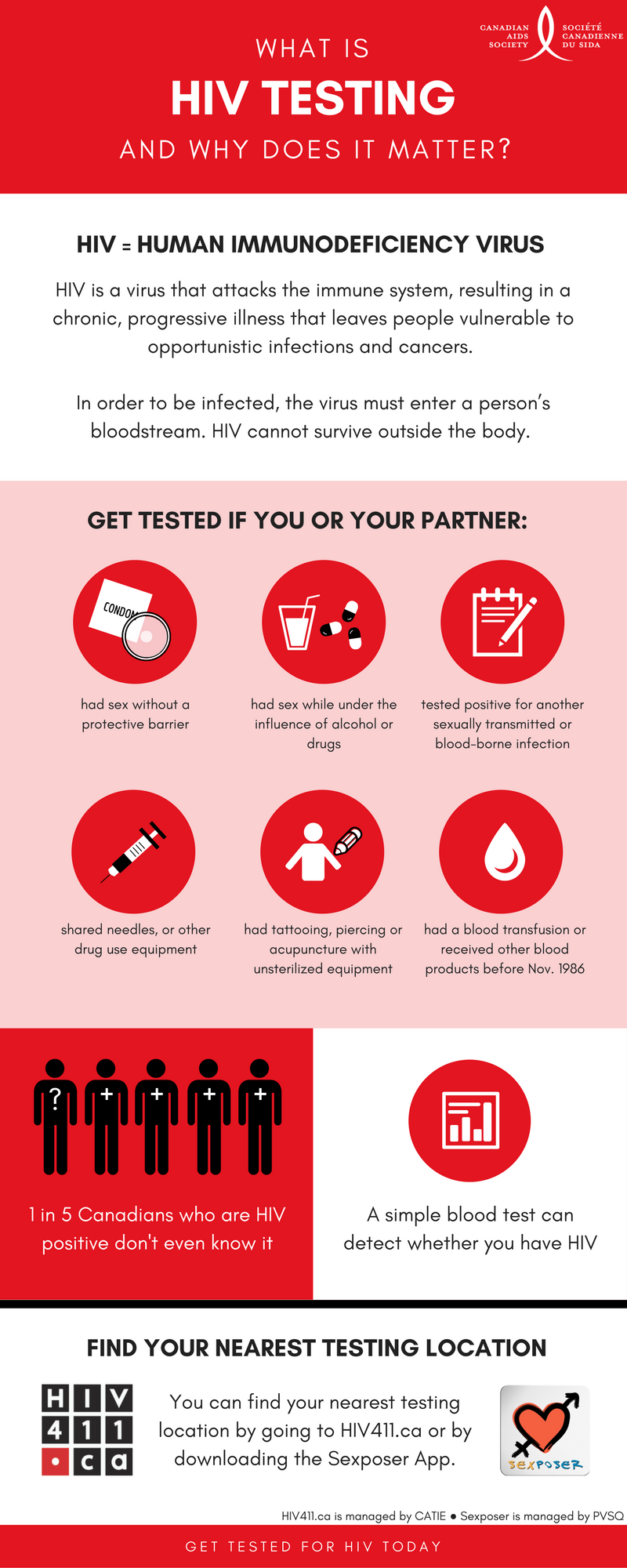
Who
If you or your partner(s) have ever:
- Had sex without using a protective barrier.
- Had sex while under the influence of alcohol or drugs.
- Tested positive for another sexually transmitted or blood-borne infection (e.g. syphilis, gonorrhea, chlamydia, hepatitis B, hepatitis C, etc.).
- Shared needles, syringes or other drug use equipment.
- Had tattooing, piercing or acupuncture with unsterilized equipment.
- Had a blood transfusion or received other blood products before November 1986.
What
HIV – the Human Immunodeficiency Virus – is a virus that attacks the immune system, resulting in a chronic, progressive illness that leaves people vulnerable to opportunistic infections and cancers. In order to be infected, the virus must enter a person’s bloodstream. HIV cannot survive outside the body. An HIV test is a simple blood test that detects whether or not you have HIV antibodies in your blood.
When
Anyone who engages in risky behaviour should be tested. You should get tested no later than three months after the first time you engaged in risky behaviour. The Public Health Agency of Canada recommends getting tested as early as possible, and ideally as a part of your regular check-ups.
Where
HIV testing is available through physicians, at clinics and in hospitals. To locate a testing centre in or near your community, call your provincial/territorial HIV/AIDS hotline.
Why
Testing provides you with an opportunity to reduce anxiety about your HIV status and to establish a baseline for your overall health care.
If the result is “negative”:
- You will have the opportunity to receive information about protective measures and behaviours necessary to prevent HIV infection.
If the result is “positive”:
- You will have the opportunity to get information, counselling, care, treatment and support in the management of HIV infection as well as learn about how to avoid possible re-exposure and how to prevent infecting others.
How
- HIV testing is based upon informed consent.
- Testing is recommended at the time of potential exposure and at three weeks following a known or suspected exposure to HIV.
- If the test is negative at three weeks, repeating the test three months following the most recent exposure can confirm the initial negative result. This is known as the “window period” which is the time after acquisition of HIV infection when a person is highly infectious but tests negative on HIV antibody screening because antibodies are not immediately produced.
- If you are tested during the window period you should get counselling on the importance of engaging in safer sex/drug use practices to avoid the potential for onward transmission of HIV.
- An individual who routinely engages in risk behaviours remains in a continuous window period and should be encouraged to undertake testing more frequently than once per year.
Pre-test counselling
Pre-test counselling can change, depending on:
- The testing situation.
- Any prior experiences with HIV testing.
- The resources and capacity of the care provider.
Testing
- With standard test a small sample of blood is taken from your arm and sent to a lab.
- With rapid testing your finger is pricked and the resulting drop of blood is tested at the clinic while you wait. Not all testing sites offer rapid testing.
- There are three protocols for testing:
- Nominal is the most common mode of testing. It uses the full name of the person being tested at all stages of the testing process.
- Non-nominal or Coded testing means that the test facility knows the person’s identity, but uses a code for the HIV lab test requisition, so the lab does not have the person’s name.
- Anonymous testing is done in specially designated clinics that use codes to carry out testing; no identifying information is collected or recorded.
- In each case, your privacy and confidentiality will be protected
Post-test counselling
If the result is “negative”:
- You will be made aware of the “window period” and follow-up testing may be recommended.
- You may be encouraged to discuss HIV testing with your partners.
- You will be given information on reducing future risk of exposure to HIV.
If the result is “positive”:
- You will be provided with counselling and referred for treatment information.
- You will be given information on reducing future risk of exposure to HIV.
- All provinces and territories have to report HIV-positive test results and/or AIDS diagnoses, meaning that provincial/territorial health authorities must be informed of results.
- Shortly thereafter, you will be asked for information about your partners, and partner notification will be discussed.
For more information on testing sites in your area visit HIV411.ca (managed by CATIE) or download the Sexposer App (available for iOS and Android, and managed by Portail VIH/sida du Québec)
